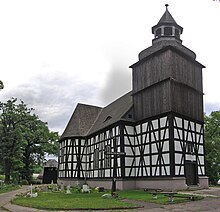Sułów (Milicz)
Sułów (German Sulau ) is a village in the urban and rural municipality Milicz ( Militsch ) in Powiat Milicki in the Lower Silesian Voivodeship in Poland.
Geographical location
The village is located in Lower Silesia not far from the Bartsch ( Barycz ), about nine kilometers southwest of Milicz and 43 kilometers north of Wroclaw .
history
In 1351, Duke Konrad I of Oels acquired Sulau Castle. It lay between two arms of the Bartsch, the crossing of which it was supposed to protect. A settlement was built north of the castle and was counted among the towns in 1474. As early as 1329, the area, together with the Duchy of Oels, was given to the Crown of Bohemia as a fief , which the Habsburgs held from 1526 . Around 1500 the castle was destroyed and not rebuilt. In 1595 Sulau came together with the manor to the burgrave Otto von Dohna . In 1654 the "little town" Sulau with the associated villages achieved the rank of a free minority . In 1680 the Counts of Burghauß built Sulau Castle . The town charter applied for by the registrar in 1694 was not granted until 1755.
After the First Silesian War in 1742, Sulau and most of Silesia fell to Prussia . Around 1800 the minority Sulau comprised the city of Sulau and 14 villages, including a colony, and a garrison consisting of a squadron of hussars from Regiment No. 1 was stationed in Sulau .
In 1816 it was incorporated into the newly established Militsch district, with which it remained connected until 1945. In 1874 the Sulau-Land district was established. The last owners were the Counts of Schweinitz . The main source of income for the townspeople was agriculture. Around 1900 there was a Protestant and a Catholic church in the city.
In 1945 Sulau belonged to the district Militsch in district Breslau the Prussian province of Lower Silesia of the German Reich . The inhabitants of the city were German and mostly Protestant.
After the Second World War , Sulau and almost all of Silesia were placed under Polish administration by the Soviet occupying power in 1945 . The Poles introduced the place name Sułów for Sulau and withdrew the town charter. In the following period, the German natives were expelled from Sulau by the local Polish administrative authority and replaced by Poles. In 1961 about 1100 inhabitants were counted.
Population development
| year | Residents | Remarks |
|---|---|---|
| 1787 | 614 | |
| 1825 | 643 | the castle community next to it 641 |
| 1905 | 1,085 | mostly evangelicals |
| 1933 | 1,133 | |
| 1939 | 1,175 | |
| 1961 | approx. 1,100 |
Attractions
- Remnants of the wall of Suhlau Castle, mentioned in 1351, have survived.
- Sulau Castle with castle park, built in 1680 by the Counts of Burghauß.
- The Catholic Church of St. Peter and Paul (Kościól ŚŚ Piotra i Pawła) was built from 1731–1734 in half-timbered construction on the site of several previous buildings. The bell tower was built in 1837.
- At the church there is an Art Nouveau rectory built around 1900.
- The church of St. Mary, which was Protestant until 1945, was built in 1765–1767 as a half-timbered round building by Silvius von Burghauß. After 1945 it was expropriated in favor of the Polish Roman Catholic Church and dedicated to St. Consecrated to Our Lady of Czestochowa (Kościól MB Częstochowskiej) . The free-standing bell tower was built in 1821.
literature
- Hugo Weczerka (Hrsg.): Handbook of the historical places . Volume: Silesia (= Kröner's pocket edition . Volume 316). Kröner, Stuttgart 1977, ISBN 3-520-31601-3 , pp. 526-527.
- Dehio Handbook of Art Monuments in Poland. Silesia. Deutscher Kunstverlag, Munich et al. 2005, ISBN 3-422-03109-X , pp. 893f.
Web links
Individual evidence
- ^ A b Johann Adam Valentin Weigel : Geographical, haturhistorical and technological description of the sovereign Duchy of Silesia. Part 9: The class lords of Wartenberg, Goschütz, Militsch; the minorities, Sulau, Neuschloß, Freihahn, Loskau, Odersberg etc. Berlin 1805, pp. 64-66.
- ↑ Sulau-Land district
- ↑ a b Meyer's Large Conversation Lexicon . 6th edition, Volume 19, Leipzig / Vienna 1909, p. 193.
- ↑ a b c Hugo Weczerka (ed.): Handbook of historical sites. Volume: Silesia (= Kröner's pocket edition. Volume 316). Kröner, Stuttgart 1977, ISBN 3-520-31601-3 , p. 526.
- ^ A b Michael Rademacher: German administrative history from the unification of the empire in 1871 to the reunification in 1990. militsch.html # ew39milisulau. (Online material for the dissertation, Osnabrück 2006).




